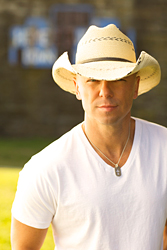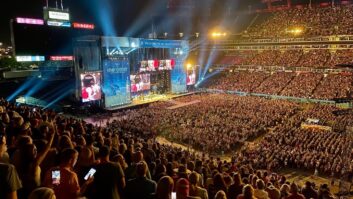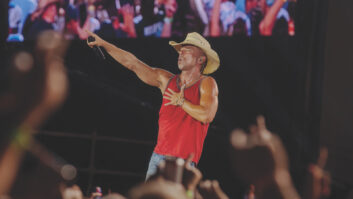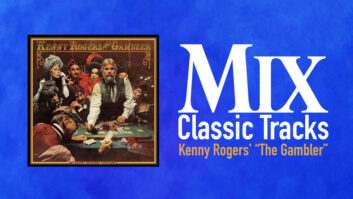
Kenny Chesney
Kenny Chesney’s latest rock-infused country album debuted at Number One on the Billboard 200 chart. Again. Hemingway’s Whiskey (BNA Records) is his sixth full-length to enter the charts at the top, but Chesney doesn’t take success for granted. In fact, he says he and his producer, Buddy Cannon, worked harder and longer on this release than on anything else he’s recorded. Mix had the opportunity to ask Chesney about his work in the studio.
Mix’s former Nashville editor Peter Cooper reported in The Tennessean that you actually ripped this record up and re-recorded most of it. What happened?
Well, I had a perfect-case scenario in my head when I was on the road last year. When I got off the road, I wanted to be completely done. In my head, I decided that when I got off the road in 2009, I was going to be done with my record, done with my tour, and I was going to take 2010 off.
Awesome plan.
Yeah. So I made a record, I mixed it, sequenced it, everything. I got a CD of all 12 songs, put it in my car and realized that I didn’t have the record that I wanted to make. The record sounded good, but the songs were… They were just songs. They wouldn’t have moved anybody, in my opinion.
Was that because of the songs themselves, or the way they’d been produced?
It was just the depth of the songs. The overall feeling of the record wasn’t what I felt like I needed to make, and it was frustrating for me because I wanted my record to be done, but it wasn’t.
So, called Buddy Cannon, my producer, on my way home. I’d just left the studio with this music that we’d been working on and mixing for a month, and I told him that we only had four songs.
How’d he take that?
[Laughs.] He took it okay I guess. I told him I realized I’d made the record in a tired state, and that’s not how I wanted this record to be.
Which four of the songs on the album are from the original sessions?
“Seven Days,” “The Boys of Fall,” “Live a Little” and… wait, there are only three actually. There was another song I was thinking of that we recorded that didn’t make the record.
So, we had to go to work again. I wrote “Reality” after that, and I was able to make this record pulling back from everything and not being on this cycle that we get so used being on of making records and touring. I had been going on the road on Thursday, Friday, Saturday night, coming home on Sunday, being in the studio Monday, Tuesday, Wednesday. When we started over and made Hemingway’s Whiskey, I was off the road. Buddy and I were able too really dig in and work with the songs, work with the musicians and talk about the music and what it meant. It gave us a chance to sonically spend time on it. I think we spent more time mixing this record than any record ever, and I wasn’t doing it after flying in from somewhere. I had not really had that luxury since we made the No Shirt, No Shoes, No Problems album.
So you had to plan a vacation to carve out time to work this way.
Yeah. [Laughs] And in doing that, I became more creative in the studio than I’d ever been, and I’m really proud of the record we made now. I just felt that the fans and I have invested so much together, and the record I initially made wasn’t protecting that investment.
Is that a goal that you have in your mind when you’re making a record—keeping that trust with your fans?
I think it’s important, but I think the reason that I’m most proud of this record is I think there’s a lot of what people expect, but there’s also a lot that’s unexpected.
What studios did you work in when you went back to the drawing board?
We mixed all of it in Blackbird with Justin Niebank. There were overdubs done in sporadic places, too, but the majority of what we did was done there and at Sound Emporium.
In general, how do you find material and start a new record?
Buddy and I have been working together a long time, and Buddy has great song sense. He’s a great songwriter himself, and he has soaked up a lot of song sense throughout the years in this town. I trust him a lot: He’s honest with me, and I’m honest with him, and both of us are always looking [for songs to record]. He’ll send me something here and there, and I’ll do the same, but I just think that for this record I cut a few songs early on that I had no business recording. I didn’t have “You and Tequila” on that first record, I didn’t have “Somewhere With You.” I didn’t have all these different little characters and chapters and twists and turns.

You and Buddy Cannon are both credited as producers on the album.
How does it work with you sharing production duties in the studio?
We
have that mutual respect when it comes to song sense, and he knows I’m
going to want to turn the guitars up a little loud, and I know he’s
going to want them down. I thank Buddy for telling me to turn down the
guitars, and I also thank Justin for turning them back up when Buddy
left the room!
How do you like to lay down tracks when you make a song? Is it a
piece-by-piece process? Do you like to record live with your band?
We’ve
done it both ways, but on this one, we pretty much did it live. I
wanted to capture a live feel. Especially on the last six records, I’ve
wanted to capture the live element of what we do. That’s hard to do
sometimes because you get creative and artistic, and that doesn’t
necessarily bring the live element into it. But when you cut live, you
don’t overthink yourself.
As a producer, I’ve learned to treat different songs different ways,
obviously, but you should always picture yourself doing [a song] for a
lot of people, I’ve always felt that I needed to keep in mind the kid
that I was, watching my heroes play, and that’s how I approach going in
to track.
Do you like to sit in on the mix?
Yeah, but not the
whole time. Justin gets it to a place he’s happy with, and then Buddy
and I will come in there and sit with him for a couple hours and
finesse it. Justin and I have a really great working relationship. He’s
learned to predict what I’m going to do. The last part of Hemingway’s
Whiskey, there wasn’t a lot of twisting and turning of the knobs when I
came in there, because it sounded really round and sonically good when
we got done. It took a couple of records for Justin to be able to
predict what I’m going to do. Now, I’m in there when we close all the
mixes, but I’m not in there when he’s getting kick drum sounds.
Do you enjoy that part of record making?
I really do,
just because I love the pure process of hearing a song come alive. If
somebody’s just got a guitar and a vocal and they give me their song, I
love the whole process of taking that song into the studio, making a
record on it, and living with the rough mix of that song for a good
while. When your ears get used to that, you go in and really make it a
record.
It’s tough sometimes because I can get really excited and out-think
myself. I have to try really hard to keep everything in perspective,
because a lot of stuff sounds really great in a studio on big speakers;
that’s why I’ve got to live with it for a while. Justin has taught me a
lot about not overthinking it. You can mix the hit out of it as Barry
Beckett used to say. You can sit here and turn knobs all day long and
lose your feel. That’s what I’ve learned the most from guys like Buddy
and Barry and Justin.
When you go on the road, is it a goal to make it sound like the final mix on your record?
Well,
yeah, but every environment is different. Doing stadium shows—there’s a
learning curve there. The first couple of years, I would be really
frustrated because I couldn’t find it. Even in my ear monitors, it was
just a different sound. I’ve had to learn a lot, but we’ve got that
dialed in now. I think our live mix does reflect the record, and I
think the record reflects the live element. I’ve been working on that
through trial and error for several years now, and even though our
mixes are pretty edgy, I still like the vocal to lead the track instead
of the track leading the vocal. That’s what I’m going for, and I’m
almost always going get pretty loud. I love people to feel that bass
drum in their chest. That’s what turned me on as a kid watching my own
heroes.
Who were your heroes as a kid?
There were so many! My
first concert I ever saw, I think, was Bryan Adams opening for
Aerosmith. I was also always really excited about the guys and girls
who wrote their own songs and played, too. Springsteen was huge, but I
actually never saw him live until a couple years ago. I was a kid who
loved Van Halen. I listened to everything.
In east Tennessee, you’re consumed by country music, and that’s the way
I sing and the way I talk—I can’t help it. But I listen to everything,
and I think that’s reflected in the ways I mix my records and track my
records.
What country music do you like?
I think Zac [Brown] is
doing a good job. I like his records a lot. Willie Nelson I love. That
was a highlight of my life when Buddy and I produced a record on him
(for more on Willie Nelson’s album Moment of Forever, read “Nashville Skyline” from Mix’s July 2008 issue).
That was a lot of fun. It was one of the most inspirational moments of
my career. I still love George Jones, too. He sang on my record [on
“Small Y’all”] and has been a part of my life; he’s like a father
figure to me. I thought it was important to push him on my record
because there’s starting to be a generation of people out there that
doesn’t know the genius of him. I still love to hear Strait sing, and I
still love to hear Reba sing. I love old Alabama records. Jackson
Browne, [Jimmy] Buffett, [John] Mellencamp. There are all kinds of
people who wrote their own songs that I love.
Do you finally get some time off now?
Yeah, I think
so. I’m going to finally have my summer vacation, even though we’re
closing in on Halloween. I’m looking forward to it. But I know I’ll get
anxious and I know the band gets anxious to get out on the road and
feel the energy. We’ll be back out in the spring.
Barbara Schultz is Mix magazine’s copy chief.
Visit Kenny Chesney online at www.kennychesney.com.




